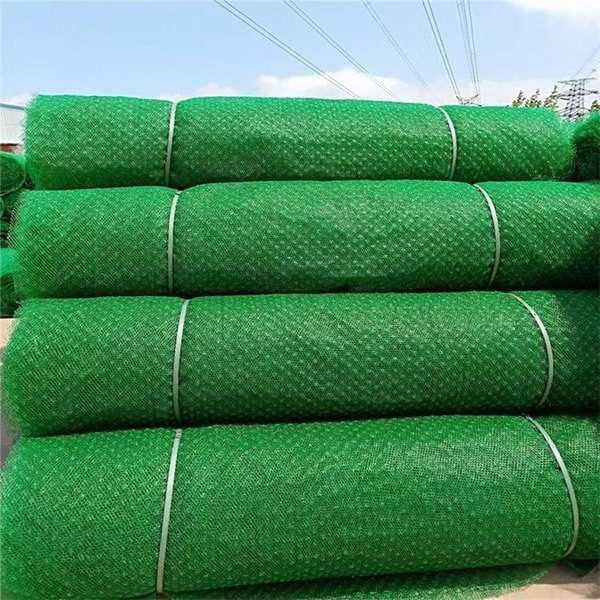Three-dimensional vegetation nets
- Commodity name: Three-dimensional vegetation nets


Keyword:
Three-dimensional vegetation nets
- PRODUCT DESCRIPTION
Three-dimensional vegetation network slope protection refers to the use of active plants and combined with geosynthetics and other engineering materials to build a protection system with its own growth ability on the slope surface, and strengthen the slope through the growth of plants. According to the characteristics of slope topography, soil quality and regional climate, a layer of geosynthetics is covered on the surface of the slope and a variety of plants are planted according to a certain combination and spacing. Through the growth activities of plants to achieve the purpose of root reinforcement, stems and leaves to prevent erosion, after the ecological slope protection technology, can form a dense vegetation cover on the slope, form a tangled root system in the topsoil layer, effectively inhibit the erosion of the slope by rainstorm runoff, increase the shear strength of the soil, reduce the pore water pressure and soil gravity, so as to greatly improve the stability and anti-erosion ability of the slope.
Slope protection mechanism
The anti-erosion effect of vegetation is realized through its three main components: first, the growth layer of the plant (including tepals, leaf sheaths, leaves, and stems) prevents the surface soil of the slope from being directly eroded by rain through its own dense cover, reduces the scouring energy of storm runoff and the speed of surface runoff, thereby reducing soil loss; the second is the humus layer (including the interface between the deciduous layer and the rhizome), which provides a protective layer for the surface soil of the slope. The third is the root layer, which strengthens and anchors the surface soil of the slope to provide mechanical stability. In general, in the early stage of plant growth, because the root system formed by a single plant is only loosely tangled, there is no long lying root system, which is easy to separate from the soil layer and cannot play a protective role. The application of three-dimensional net is to enhance the effect of the above three aspects to achieve more thorough shallow protection. One is to increase its protective performance and mechanical stability within a certain thickness range; Second, due to the existence of the three-dimensional network, the huge root system of the plant is connected with the network reinforcement of the three-dimensional network to form a plate structure (equivalent to the reinforcement of the surface soil of the slope), thereby increasing the tensile strength and shear strength of the protective layer, limiting the expansion of the phenomenon of "gradual destruction" (erosion will directly cause damage to a single plant, and the damaged area will increase with the passage of time) caused by erosion, and finally limit the occurrence of the sliding and uplift of the shallow surface layer of the slope.
The role of slope protection
The three-dimensional vegetation network slope protection technology integrates the advantages of geotechnical network and plant slope protection, and plays the role of composite slope protection. When the vegetation coverage rate of the slope reaches more than 30%, it can withstand the erosion of light rain, and when the coverage rate reaches more than 80%, it can withstand the erosion of heavy rain. When the plants are growing luxuriantly, the runoff velocity that can resist erosion can reach 6 m/s, which is more than twice that of ordinary turf. The existence of geotechnical network has a good effect on reducing the water evaporation of slope soil and increasing the amount of infiltration. At the same time, because the geonet material is black polyethylene, it has the effect of heat absorption and heat preservation, which can promote seed germination and is conducive to plant growth.
Quick protective measures
(1) When there is a contradiction between the construction period and the vegetation cultivation period, when the project enters the rainstorm season just after completion, it is necessary to take "reinforced turf" to quickly protect the project, so that the anti-erosion vegetation can be fully covered after completion. "Reinforced turf" uses a three-dimensional vegetation network to pre-cultivate turf on the open space near the lawn plantation or construction site, and after the lawn is formed, it can be rolled up in whole or in blocks, and then laid on the slope to be protected.
(2) In arid areas that are difficult to control, soil coagulants can be used, and the selected suitable grass seeds can be mixed and sprayed with soil coagulants after special treatment (grass seeds can also be sown first, and then soil coagulants can be applied). At the same time, the coagulant reduces the evaporation of water in the soil, ensures the water supply of grass seeds to a certain extent, and greatly improves the survival rate of grass seeds.
Construction technology
Slope treatment
Clean up the debris on the slope, and tamp the low-lying backfill to ensure a smooth slope.
Laying of three-dimensional nets
(1) Laying the three-dimensional vegetation network along the slope from top to bottom on the slope surface, and the net and the slope surface are kept smoothly combined.
(2) The embedded three-dimensional net needs to be extended 40~80cm when it is laid on the top of the slope, buried in the soil and compacted.
(3) Anchoring The three-dimensional mesh is fixed from bottom to top with U-shaped steel bars above ф6mm, the U-shaped steel bars are about 15~30cm long, about 8mm wide, and the spacing of U-shaped steel bars is about 1.5~2.5m, and the middle is assisted by 8# U-shaped iron nails or bamboo nails.
(4) Covering the soil The three-dimensional vegetation net is laid, and the soil is evenly covered on the three-dimensional vegetation net, and the net bag is covered until there is no empty package, and the soil thickness of the three-dimensional vegetation net is not less than 12mm. Then the fertilizer, auxin, and cementant are mixed evenly in a certain proportion and applied to the surface layer. The fertilizer is nitrogen:phosphorus:potassium=15:15:15 or nitrogen:phosphorus:potassium=10:8:7 compound fertilizer and N-containing organic matter, and the fertilizer amount is about 30~50g/㎡.
Spraying
After the soil backfill is completed, hydraulic spraying is carried out, that is, the grass seeds (sprayed about 25 grams per square meter) and the adhesion agent, wood fiber, fertilizer, auxin, humectant and water that promote its growth are mixed and stirred in a certain proportion to form a uniform mixture, which is evenly sprayed on the slope through the hydraulic spraying machine.
cover
After the spraying and grass planting construction is completed, the surface of the slope is covered with a non-woven fabric to maintain the moisture of the slope surface and reduce the erosion of the seeds by rainfall, so as to promote the growth of the seeds. If the temperature is too high, there is no need to cover to avoid the occurrence of pests and diseases.
Conservation management
After the spraying is completed, it is necessary to maintain it regularly until the lawn is completed. When the lawn grows to about 5cm, the non-woven fabric can be uncovered.
Slope protection features
Before the turf grows, the embankment can be protected from wind and rain.
It can keep the grass seeds evenly distributed on the slope and avoid being lost by wind and rain.
The net mat can absorb a lot of heat energy, enhance the ground temperature, promote the germination of grass seeds, and prolong the growth period of plants.
The compound protective layer formed by the growth of plants can withstand the erosion of high water levels and high flow rates.
It can replace concrete, asphalt, stone and other slope materials, and is mainly used for slope protection of roads, railways, rivers, dams and other slopes.
Product specifications and performance parameters of vegetation nets
| Project\Specifications | Three-dimensional mesh EM2 | Three-dimensional mesh EM3 | Three-dimensional mesh EM4 | Three-dimensional mesh EM5 |
| Quality control tensile strength(KN/m)≥ | 0.8 | 1.4 | 2.0 | 3.2 |
| Weight(g/m) | 220 | 260 | 350 | 430 |
| Thickness (mm) | 10 | 12 | 14 | 16 |
| Width(m) | 2.0 | 2.0 | 2.0 | 2.0 |
Factory appearance
Shandong Xinying New Materials Co., Ltd. will be strong economic and technical strength, excellent product quality, casting China geo building materials new brand new image.

Get A Quote
Note: Please leave your email address, our professionals will contact you as soon as possible!
Related Products







